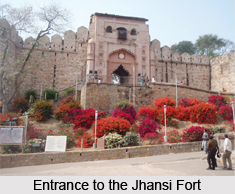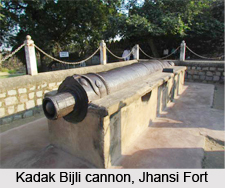 Jhansi Fort or ‘Rani Jhansi ka Quila’ is a fortress standing on a rocky hillock called Bangara, in the heart of the city of Jhansi situated on the south-western hem of the Uttar Pradesh state. It was constructed by Raja Bir Singh Ju Deo, the king of Orchha, in 1613, on the Bangara hill in the erstwhile town of Balwantnagar, presently known as Jhansi.
Jhansi Fort or ‘Rani Jhansi ka Quila’ is a fortress standing on a rocky hillock called Bangara, in the heart of the city of Jhansi situated on the south-western hem of the Uttar Pradesh state. It was constructed by Raja Bir Singh Ju Deo, the king of Orchha, in 1613, on the Bangara hill in the erstwhile town of Balwantnagar, presently known as Jhansi.Historical Significance of Jhansi Fort, Uttar Pradesh
The Jhansi Fort remained under the control of the Bundellas for 25 years, after which it was taken over by the Mughals who sustained control for the next 100 years. In 1729, the Mughal battalion led by Mohammed Khan Bangash attacked Maharaja Chattrasal Bundela of Panna, which Maratha Peshwa Shrimant Baji Rao I helped defeat. As a symbol of gratitude, Maharaja Chattrasal offered a part of his state to Peshwa Baji Rao I, which included Jhansi. In 1742, Naru Shankar, a Maratha chief, was made the ‘subedar’ of Jhansi and during his 15 years tenure, he brought alterations and extensions to the fort that came to be known as Shankargarh, largely owing to the construction of a Lord Shiva temple there. He is credited for having founded the city of Jhansi, stretching upto a circumference of 7.3 kilometres. The city wall and its main gate were added by Shiv Rao Bhau during his tenure in 1796-1814. After the death of Shiv Rao, his grandson Ramchandra Rao was made the ‘subedar’ of Jhansi. His poorly administered term ended with his death in 1835 after which his successor Raghunath Rao III, too with inefficient administration left Jhansi in a very poor financial position. He died in 1838, succeeded by Raja Gangadhar Rao, an able administrator who was accepted as the ruler of Jhansi by the British rulers.

The Marathas continued to rule Jhansi and the Jhansi Fort up till the death of Raja Gangadhar Rao in 1853, after which, his adopted son Damodar Rao ascended to throne under the administration of Gangadhar Rao’s wife Manikarnika, who was later named Rani Lakshmi Bai. But the British did not recognise their claim to the throne and declared the state as having lapsed to the British government. This illegal annexation of Jhansi aroused great discontent among the Maratha and the Bundella chiefs of the region which was further fuelled by the freedom struggle that waged in 1857.
Revolt of Rani Lakshmi Bai from Jhansi Fort
The Jhansi Fort was a major stronghold during the Sepoy Mutiny of 1857. The revolt in Jhansi was led by none other than Rani Lakshmi Bai, popularly known as ‘Jhansi ki Rani’ (Queen of Jhansi) in the chronicles of Indian history. Just below the walls at the fort’s approach, is a bizarre blood-and-guts diorama of the battle in which Rani Lakshmi Bai succumbed to death.
In 1858, Rani Lakshmi Bai valiantly led the battle from the fort against the British East India Company armed troops, assisted by Raja Mardan Singh of Banpur and Nana Saheb, preparing her army with exemplary courage, valour and organizing capacity. The British troops fought under the command of General Hugh Rose for seventeen days, continuously pounding the fort with their artillery. They failed in breaching the walls of the fort which were very thick and strong. Rani Lakshmi Bai put up a resolute and defiant defence, returning the attacks with equal vigour. She placed herself at the head of these battalions, fighting with a sword in each hand and holding her horse’s reins in her mouth. The battalion fought aggressively and suffered heavy casualties against the British forces who succeeded in capturing the fort as well as the city. Rani Lakshmi Bai made a daring escape from the fortress by letting herself with her son Damodar Rao, down from a turret window on a horseback.

After capturing Jhansi, the British handed over the fort and the city to Jayajirao Scindia, the Maharaja of Gwalior. After her escape from Jhansi, Rani Lakshmi Bai rode on to the ancient city of Kalpi, engaging in fierce fighting on the way. She further headed to Gwalior and captured the fort there. Hugh Rose after losing many times, won the battle in Gwalior and re-seized the fort.
Rani Lakshmi Bai died mortally wounded. Her body was cremated and her wish that it did not fall into British hands was fulfilled. She has been given a place amongst the greatest women in the history of the world and is an illustrious figure in Indian history. The British generals were aghast at her daring and Hugh Rose described her as ‘the bravest and best military leader of rebels’.
The city and the fort of Jhansi were again expropriated by the British from the Gwalior state in 1868.
Structural Features of Jhansi Fort, Uttar Pradesh
Jhansi Fort showcases the architecture of the Bundellas and the Marathas. It sprawls over an area of 15 acres (61,000 square metres), stretching about 312 metres long and 225 metres wide. Altogether, there are 22 bastions with a huge fortification wall defended by a moat on two sides. A bastion on the eastern side was demolished, which was reconstructed by the British. The granite walls are between 16 and 20 feet high and meet the city walls to the south. The southern face of the fort is almost perpendicular.
For more, visit the link given below:
https://www.indianetzone.com/64/jhansi_fort.htm
https://www.indianetzone.com/64/jhansi_fort.htm